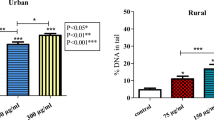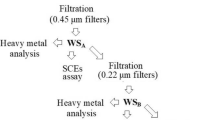Abstract
Road tunnel construction involves the use of explosives and diesel-powered machines in a very limited indoor space. Tunnel construction workers are thus exposed to a variety of toxic substances, including dust, asbestos, silica, concrete, diesel fumes, and oil mist. In this study, the low noise miniaturized Sioutas Cascade Impactor (SKC) has been used to collect PM samples as a function of particle size (i.e., aerodynamic diameter). Airborne particulates were sampled into a road tunnel (final length 2391 m) under construction near the village of Pale, Municipality of Foligno, Umbrian Apennines (State Highway 77 “Val di Chienti”). Three sampling sessions were performed: (i) in the West yard, during dislodging of rocks; (ii) in the East yard during drilling of rocks, and (iii) during scaling and grouting with quick-drying shotcrete. The aim of this study was to characterize size-fractionated PM samples for their cytotoxic/genotoxic potentials. Toxicological evaluation was carried out in vitro on A549 lung carcinoma cells: cytotoxicity was assessed by Trypan blue dye exclusion assay, whereas genotoxicity was assessed by comet assay (primary DNA damage) and cytokinesis-block micronucleus (CBMN) Cytome assay (cytogenetic effects). Primary DNA damage (i.e., strand breakage) was mainly caused by coarse fractions A (Ø > 2.5 μm) sampled in the West yard (sample i) and in the East yard (sample iii). Cytogenetic effects were mainly caused by the fine fractions AF (aerodynamic Ø < 0.25 μm) sampled in the East yard (sample ii). Results reported in this article show that particulate matter (PM) samples collected underground (i.e., during road tunnel construction) may trigger various cytotoxic/genotoxic effects. The recent classification of air pollution and PM itself as carcinogenic to humans (group 1) by the IARC makes indoor/outdoor air pollution a growing matter of concern. Our results highlight the need in this occupational setting for a reduction, if applicable, of PM emission (prevention), or an implementation of work practices by stressing the importance of proper use of protective equipment (protection).



Similar content being viewed by others
References
Arhami M, Minguillon MC, Polidori A, Schauer JJ, Delfino RJ, Sioutas C (2010) Organic compound characterization and source apportionment of indoor and outdoor quasi-ultrafine particulate matter in retirement homes of the Los Angeles Basin. Indoor Air 20:17–30. https://doi.org/10.1111/j.1600-0668.2009.00620.x
Bakke B, Ulvestad B, Stewart P, Eduard W (2004) Cumulative exposure to dust and gases as determinants of lung function decline in tunnel construction workers. Occup Environ Med 61:262–269
Benbrahim-Tallaa L, Baan RA, Grosse Y, Lauby-Secretan B, El Ghissassi F, Bouvard V, Guha N, Loomis D, Straif K, IARC Monograph Working Group (2012) Carcinogenicity of diesel-engine and gasoline-engine exhausts and some nitroarenes. Lancet Oncol 13:663–664
Bomhard EM (2017) Particle-induced pulmonary alveolar proteinosis and subsequent inflammation and fibrosis: a toxicologic and pathologic review. Toxicol Pathol 45:389–401. https://doi.org/10.1177/0192623316688959
Bonetta S, Gianotti V, Bonetta S, Gosetti F, Oddone M, Gennaro MC, Carraro E (2009) DNA damage in A549 cells exposed to different extracts of PM(2.5) from industrial, urban and highway sites. Chemosphere 77:1030–1034. https://doi.org/10.1016/j.chemosphere.2009.07.076
Borak J, Lefkowitz RY (2016) Bronchial hyperresponsiveness. Occup Med (Lond) 66:95–105. https://doi.org/10.1093/occmed/kqv158
Carey IM, Atkinson RW, Kent AJ, van Staa T, Cook DG, Anderson HR (2013) Mortality associations with long-term exposure to outdoor air pollution in a national English cohort. Am J Respir Crit Care Med 187:1226–1233. https://doi.org/10.1164/rccm.201210-1758OC
Celik A, Diler SB, Eke D (2010) Assessment of genetic damage in buccal epithelium cells of painters: micronucleus, nuclear changes, and repair index. DNA Cell Biol 29:277–284. https://doi.org/10.1089/dna.2009.0996
Collins AR, Oscoz AA, Brunborg G, Gaivao I, Giovannelli L, Kruszewski M, Smith CC, Stetina R (2008) The comet assay: topical issues. Mutagenesis 23:143–151. https://doi.org/10.1093/mutage/gem051
Dominici L, Cerbone B, Villarini M, Pagiotti R, Moretti M (2013a) In vitro genotoxicity testing of Lawsonia inermis and henna extracts in HepG2 cells by the comet assay. IJNPS 3:12–21
Dominici L, Guerrera E, Villarini M, Fatigoni C, Moretti M, Blasi P, Monarca S (2013b) Evaluation of in vitro cytoxicity and genotoxicity of size-fractionated air particles sampled during road tunnel construction. Biomed Res Int 2013:345724. https://doi.org/10.1155/2013/345724
Eastmond DA, Tucker JD (1989) Identification of aneuploidy-inducing agents using cytokinesis-blocked human lymphocytes and an antikinetochore antibody. Environ Mol Mutagen 13:34–43
Ellingsen DG, Seljeflot I, Thomassen Y, Thomassen M, Bakke B, Ulvestad B (2017) Biomarkers of endothelial activation and thrombosis in tunnel construction workers exposed to airborne contaminants. Int Arch Occup Environ Health 90:309–317. https://doi.org/10.1007/s00420-017-1199-x
Falcon-Rodriguez CI, Osornio-Vargas AR, Sada-Ovalle I, Segura-Medina P (2016) Aeroparticles, composition, and lung diseases. Front Immunol 7:3. https://doi.org/10.3389/fimmu.2016.00003
Fenech M (2007) Cytokinesis-block micronucleus cytome assay. Nat Protoc 2:1084–1104. https://doi.org/10.1038/nprot.2007.77
Fu P, Guo X, Cheung FMH, Yung KKL (2019) The association between PM2.5 exposure and neurological disorders: a systematic review and meta-analysis. Sci Total Environ 655:1240–1248. https://doi.org/10.1016/j.scitotenv.2018.11.218
George AC, Hinchliffe L, Sladowski R (1975) Size distribution of radon daughter particles in uranium mine atmospheres. Am Ind Hyg Assoc J 36:484–490. https://doi.org/10.1080/0002889758507275
Griffiths SJ (2011) Implications of individual particulate matter component toxicity for population exposure. Air Qual Atmos Health 4:189–197. https://doi.org/10.1007/s11869-010-0077-4
Hamanaka RB, Mutlu GM (2018) Particulate matter air pollution: effects on the cardiovascular system. Front Endocrinol (Lausanne) 9:680. https://doi.org/10.3389/fendo.2018.00680
Hilt B, Qvenild T, Holme J, Svendsen K, Ulvestad B (2002) Increase in interleukin-6 and fibrinogen after exposure to dust in tunnel construction workers. Occup Environ Med 59:9–12
IARC (1997) Silica, some silicates, coal dust and para-aramid fibrils. IARC monographs on the evaluation of carcinogenic risks to humans (Vol. 68). International Agency for Research on Cancer, Lyon
IARC (2014) Diesel and gasoline engine exhausts and some nitroarenes. IARC monographs on the evaluation of carcinogenic risks to humans (Vol. 105). International Agency for Research on Cancer, Lyon
IARC (2016) Outdoor air pollution. IARC Monographs on the evaluation of carcinogenic risks to humans (Vol. 109). International Agency for Research on Cancer, Lyon
Lepers C, Dergham M, Armand L, Billet S, Verdin A, Andre V, Pottier D, Courcot D, Shirali P, Sichel F (2014) Mutagenicity and clastogenicity of native airborne particulate matter samples collected under industrial, urban or rural influence. Toxicol in Vitro 28:866–874. https://doi.org/10.1016/j.tiv.2014.03.011
Lewtas J (2007) Air pollution combustion emissions: characterization of causative agents and mechanisms associated with cancer, reproductive, and cardiovascular effects. Mutat Res 636:95–133. https://doi.org/10.1016/j.mrrev.2007.08.003
Moretti M, Marcarelli M, Villarini M, Fatigoni C, Scassellati-Sforzolini G, Pasquini R (2002) In vitro testing for genotoxicity of the herbicide terbutryn: cytogenetic and primary DNA damage. Toxicol in Vitro 16:81–88
Oliver LC, Miracle-McMahill H (2006) Airway disease in highway and tunnel construction workers exposed to silica. Am J Ind Med 49:983–996. https://doi.org/10.1002/ajim.20406
Palacio IC, Barros SB, Roubicek DA (2016) Water-soluble and organic extracts of airborne particulate matter induce micronuclei in human lung epithelial A549 cells. Mutat Res 812:1–11. https://doi.org/10.1016/j.mrgentox.2016.11.003
Perrone MG, Gualtieri M, Ferrero L, Lo Porto C, Udisti R, Bolzacchini E, Camatini M (2010) Seasonal variations in chemical composition and in vitro biological effects of fine PM from Milan. Chemosphere 78:1368–1377. https://doi.org/10.1016/j.chemosphere.2009.12.071
Poma A, Arrizza L, Picozzi P, Spano L (2002) Monitoring urban air particulate matter (fractions PM 2.5 and PM 10) genotoxicity by plant systems and human cells in vitro: a comparative analysis. Teratog Carcinog Mutagen 22:271–284. https://doi.org/10.1002/tcm.10020
Pope CA, Brook RD, Burnett RT, Dockery DW (2011) How is cardiovascular disease mortality risk affected by duration and intensity of fine particulate matter exposure? An integration of the epidemiologic evidence. Air Qual Atmos Health 4:5–14. https://doi.org/10.1007/s11869-010-0082-7
Rainho CR, Correa SM, Aiub CAF, Felzenszwalb I (2016) Biomonitoring of tunnel workers exposed to heavy air pollution in Rio de Janeiro, Brazil. Air Qual Atmos Health 9:881–886. https://doi.org/10.1007/s11869-016-0391-6
Raulf-Heimsoth M, Marczynski B, Spickenheuer A, Pesch B, Welge P, Ruhl R, Bramer R, Kendzia B, Heinze E, Angerer J, Bruning T (2011) Bitumen workers handling mastic versus rolled asphalt in a tunnel: assessment of exposure and biomarkers of irritation and genotoxicity. Arch Toxicol 85(Suppl 1):S81–S87. https://doi.org/10.1007/s00204-011-0685-2
Robertson S, Miller MR (2018) Ambient air pollution and thrombosis. Part Fibre Toxicol 15(1):1. https://doi.org/10.1186/s12989-017-0237-x
Rohra H, Tiwari R, Khare P, Taneja A (2018) Indoor-outdoor association of particulate matter and bounded elemental composition within coarse, quasi-accumulation and quasi-ultrafine ranges in residential areas of northern India. Sci Total Environ 631-632:1383–1397. https://doi.org/10.1016/j.scitotenv.2018.03.095
Roubicek DA, Gutierrez-Castillo ME, Sordo M, Cebrian-Garcia ME, Ostrosky-Wegman P (2007) Micronuclei induced by airborne particulate matter from Mexico City. Mutat Res 631:9–15. https://doi.org/10.1016/j.mrgentox.2007.04.001
Schiliro T, Bonetta S, Alessandria L, Gianotti V, Carraro E, Gilli G (2015) PM10 in a background urban site: chemical characteristics and biological effects. Environ Toxicol Pharmacol 39:833–844. https://doi.org/10.1016/j.etap.2015.02.008
Silverman DT, Samanic CM, Lubin JH, Blair AE, Stewart PA, Vermeulen R, Coble JB, Rothman N, Schleiff PL, Travis WD, Ziegler RG, Wacholder S, Attfield MD (2012) The diesel exhaust in miners study: a nested case-control study of lung cancer and diesel exhaust. J Natl Cancer Inst 104:855–868. https://doi.org/10.1093/jnci/djs034
Singh NP, McCoy MT, Tice RR, Schneider EL (1988) A simple technique for quantitation of low levels of DNA damage in individual cells. Exp Cell Res 175:184–191
Taner S, Pekey B, Pekey H (2013) Fine particulate matter in the indoor air of barbeque restaurants: elemental compositions, sources and health risks. Sci Total Environ 454-455:79–87. https://doi.org/10.1016/j.scitotenv.2013.03.018
Tice RR, Agurell E, Anderson D, Burlinson B, Hartmann A, Kobayashi H, Miyamae Y, Rojas E, Ryu JC, Sasaki YF (2000) Single cell gel/comet assay: guidelines for in vitro and in vivo genetic toxicology testing. Environ Mol Mutagen 35:206–221
Tuchsen F, Hannerz H, Spangenberg S (2005) Mortality and morbidity among bridge and tunnel construction workers who worked long hours and long days constructing the Great Belt fixed link. Scand J Work Environ Health 31(Suppl 2):22–26
Ulvestad B, Lund MB, Bakke B, Thomassen Y, Ellingsen DG (2015) Short-term lung function decline in tunnel construction workers. Occup Environ Med 72:108–113. https://doi.org/10.1136/oemed-2014-102262
Velali E, Papachristou E, Pantazaki A, Choli-Papadopoulou T, Planou S, Kouras A, Manoli E, Besis A, Voutsa D, Samara C (2016) Redox activity and in vitro bioactivity of the water-soluble fraction of urban particulate matter in relation to particle size and chemical composition. Environ Pollut 208:774–786. https://doi.org/10.1016/j.envpol.2015.10.058
Villarini M, Moretti M, Fatigoni C, Agea E, Dominici L, Mattioli A, Volpi R, Pasquini R (2008) Evaluation of primary DNA damage, cytogenetic biomarkers and genetic polymorphisms for CYP1A1 and GSTM1 in road tunnel construction workers. J Toxicol Environ Health A 71:1430–1439. https://doi.org/10.1080/15287390802328580
Villarini M, Pagiotti R, Dominici L, Fatigoni C, Vannini S, Levorato S, Moretti M (2014) Investigation of the cytotoxic, genotoxic, and apoptosis-inducing effects of estragole isolated from fennel (Foeniculum vulgare). J Nat Prod 77:773–778. https://doi.org/10.1021/np400653p
Villarini M, Levorato S, Salvatori T, Ceretti E, Bonetta S, Carducci A, Grassi T, Vannini S, Donato F, Bonetta S, Verani M, de Donno A, Bonizzoni S, Bonetti A, Moretti M, Gelatti U, MAPEC Life Study Group (2018) Buccal micronucleus cytome assay in primary school children: a descriptive analysis of the MAPEC_LIFE multicenter cohort study. Int J Hyg Environ Health 221:883–892. https://doi.org/10.1016/j.ijheh.2018.05.014
WHO (2000) Particulate matter (Chapter 7.3). In: WHO air quality guidelines for Europe (2nd edition). World Health Organization, Regional Office for Europe, Copenhagen, Denmark,
Wu W, Jin Y, Carlsten C (2018) Inflammatory health effects of indoor and outdoor particulate matter. J Allergy Clin Immunol 141:833–844. https://doi.org/10.1016/j.jaci.2017.12.981
Xing YF, Xu YH, Shi MH, Lian YX (2016) The impact of PM2.5 on the human respiratory system. J Thorac Dis 8:E69–E74. https://doi.org/10.3978/j.issn.2072-1439.2016.01.19
Acknowledgements
The Authors wish to thank Prof. Silvano Monarca, former Head of the Unit of Public Health at the Dept. of Pharmaceutical Sciences, University of Perugia, for his helpful assistance during this research and constructive comments on the manuscript.
Funding
This study was part of the project “Environmental and Biological Monitoring of Genotoxic Hazards in Work Environments” funded by Istituto Nazionale per l’Assicurazione contro gli Infortuni sul Lavoro (INAIL, Italian Workers’ Compensation Authority), Direzione Regionale per l’Umbria, Perugia, Italy.
Author information
Authors and Affiliations
Corresponding author
Ethics declarations
Conflicts of interest
The authors declare that they have no conflict of interest.
Additional information
Publisher’s note
Springer Nature remains neutral with regard to jurisdictional claims in published maps and institutional affiliations.
Rights and permissions
About this article
Cite this article
Guerrera, E., Dominici, L., Levorato, S. et al. Cytotoxicity and genotoxicity of size-fractionated particulate matter collected in underground workplaces. Air Qual Atmos Health 12, 359–367 (2019). https://doi.org/10.1007/s11869-019-00667-y
Received:
Accepted:
Published:
Issue Date:
DOI: https://doi.org/10.1007/s11869-019-00667-y




